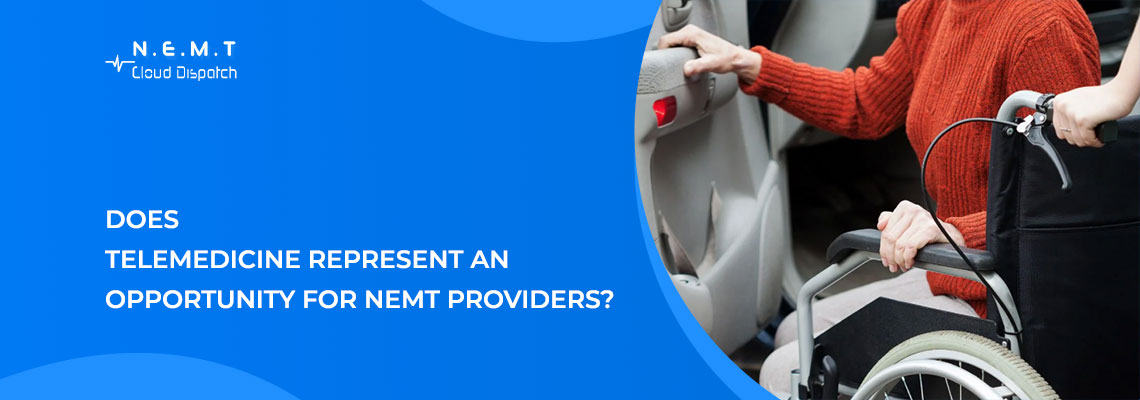With advancements in healthcare technology, telemedicine has become a crucial part of how patients access medical care. By allowing patients to consult doctors remotely, telemedicine offers a more convenient, time-efficient, and flexible approach to healthcare. However, its rise has led many to wonder what role traditional NEMT plays in this changing landscape. Surprisingly, telemedicine is not only a complement to NEMT services but also presents unique opportunities for providers.
Let’s discuss at NEMT Cloud Dispatch how telemedicine affects NEMT providers, how they can align with this trend, and how it impacts business growth.
What is Telemedicine?
Telemedicine is the use of technology to deliver healthcare services remotely. This can include virtual appointments with doctors, remote monitoring of patients, and digital consultations. Telemedicine has become widely adopted in recent years due to advancements in technology and changes in healthcare policies, especially following the COVID-19 pandemic.
For many patients, this eliminates the need for physical trips to doctors. This gives seniors an accessible alternative for routine checkups, follow-up visits and consultations.
How Telemedicine Complements Non-Emergency Medical Transportation (NEMT)
Does Telemedicine Replace NEMT?
The rise of telemedicine raises a natural question: does it replace the need for NEMT, or can it work in tandem to enhance access to healthcare? Let’s look at some perspectives on this evolving relationship.
- Minimize demand for trips: With telemedicine, there is a decrease in demand for frequent trips. Instead of long-distance visits and routine visits with mobility, seniors prefer online consultations. However, there are still many cases where in-person checkups are required, especially for procedures, tests, or treatments requiring hands-on medical staff attention.
- Increased need for specialized transport: Telemedicine can often lead to more frequent healthcare interactions for patients with chronic conditions. A virtual consultation might need further testing or treatment. There is a need for non-emergency medical transportation, and providers play their role.
- Collaboration with healthcare providers: As telemedicine and NEMT become recognized and complementary services, opportunities emerge for partnerships with healthcare providers and insurance companies. Some insurers may want to create integrated solutions that include telemedicine and NEMT coverage.
You May Also Read: Why Transportation Becomes a Barrier to Healthcare Access?
Opportunities for NEMT Growth with Telemedicine
While it’s clear that telemedicine affects NEMT demand, it also presents district opportunities for growth and service expansion in NEMT:
- Focus on the High-Need Population: Providers can focus on serving patients with conditions requiring regular treatments that can’t be handled through telemedicine. For instance, patients undergoing dialysis or physical therapy still need in-person care.
- Supporting Telemedicine Access for Non-Transportable Patients: Not every person has access to the technology or the internet needed for telemedicine. Telemedicine works to provide healthcare remotely, but some in-person visits cannot be skipped. Patients requiring physical examinations or treatments such as dialysis and chemotherapy must attend their appointments. NEMT providers can supplement the remote healthcare benefits of telemedicine in this scenario.
- Addressing Healthcare Access Gaps in Rural Areas: If rural communities don’t have healthcare access, it may also be due to a shortage of healthcare workers. Most of them are stationed in big cities because there is a higher demand and compensation for jobs in urban centers. However, with telemedicine, fewer healthcare staff can be in the rural area to serve the community. In preventive care, people can attend any educational activity or training remotely.
You May Also Read: The Impact of Telematics on NEMT Fleet Performance
Why Telemedicine is Essential for NEMT Providers
Telemedicine is transforming the landscape of the healthcare industry, bringing numerous benefits. For Non-Emergency Medical Transportation (NEMT) providers, leveraging telemedicine can significantly enhance their services and operations. Collaborating with trusted telemedicine partners can elevate their business to new heights.
Key Benefits of Integrating Telemedicine with NEMT
Here are the key reasons why telemedicine is essential for NEMT providers:
- Improved Emergency Readiness: Telemedicine ensures that NEMT providers are better equipped to handle emergencies, enhancing response capabilities.
- Enhanced Operational Efficiency: Integrating telemedicine solutions streamlines operations, contributing to sustained growth and success.
- Optimized Resource Management: Telemedicine facilitates more brilliant use and management of resources, enabling more effective allocation and utilization.
- Higher Quality Patient Care: By improving service delivery, telemedicine boosts the standard of patient care, resulting in an industry with superior transport providers.
- Expanded Networking Opportunities: Telemedicine allows NEMT providers to collaborate and build relationships with other key players in the healthcare ecosystem. Incorporating telemedicine into NEMT services benefits providers and enriches the overall healthcare experience for patients.
Evolution of NEMT Software in the Telemedicine Era
Non-emergency medical transportation (NEMT) is a vital part of the Medicaid program. It uses brokers or private transportation companies to help patients get to their medical appointments. The main idea is that investing in NEMT helps reduce missed appointments. This, in turn, helps avoid emergencies and keeps patients healthier.
Millions of patients must be taken to and from their appointments every day. This requires careful planning to ensure they reach the right places at the correct times with the proper care. One mistake in communication can disrupt the entire system. For this reason, transparent and timely communication among patients, doctors, drivers, NEMT brokers, and insurers is essential. Manual processes alone cannot manage this level of coordination, so there is a technology called NEMT software.
Conclusion
Telemedicine and NEMT services may seem like competing alternatives, but they complement each other in the larger healthcare ecosystem. Telemedicine’s growth opens up new ways for NEMT providers to support patients through coordinated care, specialized services, or partnerships with telehealth providers. By adjusting to telemedicine’s change and finding new ways to add value, NEMT providers can remain a crucial part of healthcare, improving patient outcomes and streamlining the medical journey for those in need.
In short, telemedicine provides a valuable opportunity for NEMT providers to evolve and become even more indispensable, offering patients access to both virtual and in-person care in a more integrated and efficient way.


